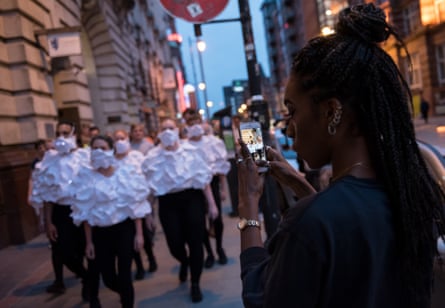Heads turn when media artist Kasia Molga and her performers walk the streets of Manchester. When they near buses belching diesel fumes, their futuristic capes and masks turn a bright red. Near a park they go green. Depending on the traffic pollution levels in the northern industrial city, their clothing pulses, flashes and changes colour from purple through to white.
Molga calls herself a “human sensor”. She has linked with atmospheric scientists at King’s College London to develop clothing that reacts to the minute particles (PM2.5s) emitted mainly by diesel engines.
A pocket-sized aerosol monitor linked to a GPS watch and a tiny Raspberry Pi computer allows pollution data collected in the street to communicate with LED lights embedded in the artists’ capes and masks. The data cannot yet be broadcast by the clothing in real time but information collected a few hours previously is used.
“The reaction has been amazing. People quickly realise it’s to do with the air and breathing. Many passers-by have been surprised and concerned that the changing colours on the costumes mean that they can ‘see’ the air pollution for the first time,” said Molga.
“I realised that my own body is the best sensor for the environmental changes around me. The act of breathing is a very intimate action – an interface which connects our inner bodies to the outside.”
Because air pollution, climate change and so many other environmental problems are largely invisible, artists are increasingly working with scientists to communicate the hazards of everyday life.
“It is really important for artists and scientists to work together,” said King’s College senior air quality analyst, Andrew Grieve. “The big challenge we have is that air pollution is mostly invisible. Art helps to makes it visible. We are trying to bring air pollution into the public realm. Scientific papers in journals work on one level, but this is a way to bring it into the street where the public is.”

The development of hi-tech clothing is expected to lead to big societal change, said Prof Frank Kelly, director of the Environmental Research Group at King’s. “Here it is being used in a really positive way – making dangerous air pollutants visible. The problem we have as scientists is people cannot see the problem.”
In a separate development, 16 children and teachers at East Barnet secondary school in London have this week been issued with portable air pollution sensors enabling the school to generate live air pollution data from both inside the classroom and on routes to and from the school.
The monitors, from London technology startup Drayson Technologies, measure carbon monoxide. The data will be fed into a time-lapse heat map that will show the pollution levels in realtime.
“We are extremely conscious of the issue of pollution and are keen to raise awareness of it among our children, parents and staff. This will enable us to understand the quality of the air inside, and around our school, and help us to devise a strategy to ensure our pupils have a minimal exposure to pollution,” said Stuart Owen, head of science at the school.
A May report on London air pollution showed that 433 of London’s 1,777 primary schools were in areas where pollution concentrations breached EU limits.
Outdoor air pollution is now one of the biggest killers in the world and responsible for nearly 9,500 deaths a year in London. In the world’s cities, it has has grown by 8% in the past five years, according to the World Health Organisation.
Comments (…)
Sign in or create your Guardian account to join the discussion